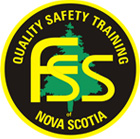Hydraulic Fluid Under Pressure Strikes Hand
Hazard Alert
Worker Injured when Leak from Hydraulic Fluid Under Pressure Strikes his Hand
The operator of a forwarder was conducting a maintenance inspection in the area of the grapple and boom. The engine was running, properly parked and the grapple lowered to the ground. He noticed what he thought was evidence of hydraulic fluid leaks on the metal of the boom arch. He reached with his bare hand around the hydraulic hoses to see if there were any leaks. Unknown to the operator, fluid under pressure was escaping in a fine stream near the area where a hydraulic hose and coupling were attached. When he passed his bare hand through the stream of fluid, the pinpoint stream of fluid under pressure was injected directly into the skin and muscle of the palm of his hand. He was treated in hospital. Several days later he was also treated for complications and infection because of the difficulty in removing the hydraulic fluid from the tissues of his hand.
WHY DID THIS HAPPEN?
An analysis of the circumstances leading up to the injury revealed a number of factors that may have directly or indirectly contributed to the accident, including the following:
- Hydraulic fluid under pressure can leak from hoses and couplings. Often the leak, because it is under high pressure, is so small that the fluid is forced out in a very fine stream under high pressure. The stream of fluid is so fine that in many circumstance it is very difficult to see with the naked eye.
- The operator deliberately place his unprotected hand into the area where the stream of fluid was being emitted. He did not wear proper hand protection, nor did he use a safe alternative method of testing for leaks such as a piece of cardboard or wood.
- Because of the oily and viscous nature of the hydraulic fluid, wounds resulting from this type of accident can easily become complicated by further tissue damage and infection.
Recommendations to Prevent a Recurrence
- Ensure that written safe work practices recognize the hazards encountered in this incident and acceptable control methods are described and made known to operators, including strong warnings that hydraulic fluid under pressure can create a significant hazard if unprotected body parts are exposed to it. Tests for these types of leaks should be done with a piece of cardboard or wood.
- Ensure that all workers are aware of and follow safe work procedures relating to routine maintenance of hydraulic components.
